December 2022
- English
- 日本語
History and Characteristics of Japanese Patterns

Fuji Eriko 
The karakusamon design printed on a furoshiki wrapping cloth
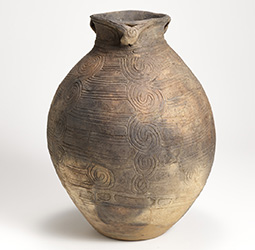
A Jomon-period pottery vessel with patterns thought to represent flowing water (Collection of Kyushu National Museum) (Diameter 32.5 cm, height 43 cm) 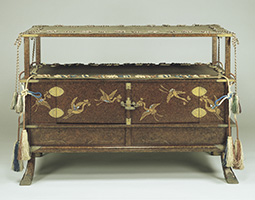
Two-tiered cabinet with a design featuring cranes and pine sprigs made with maki-e lacquer and mother-of-pearl inlay (19th century) (Collection of Tokyo National Museum) 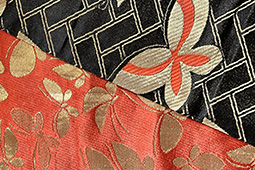
An obi kimono belt decorated with a butterfly pattern 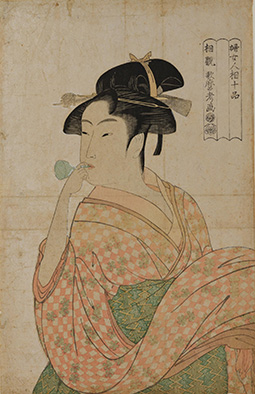
The print Young Woman Blowing a Popen (glass noisemaker) by Kitagawa Utamaro depicts a woman wearing a kimono printed with the ichimatsumon pattern (Collection of Tokyo National Museum) 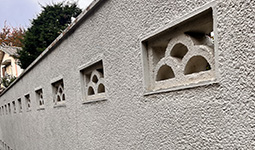
The familiar wave-like seigaihamon design used to decorate a wall 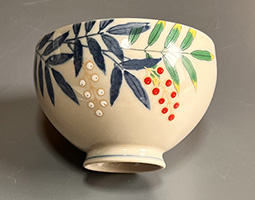
A bowl decorated with a nanten plant pattern 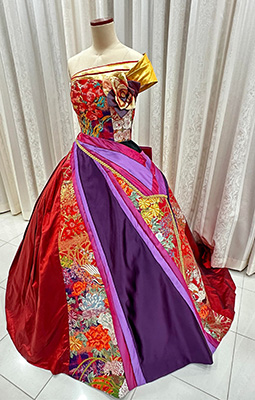
A wedding dress, “Wa dress,” by designer Ueda Eiko featuring patterns such as peony flowers that symbolize welfare and prosperity

We interviewed Fuji Eriko, a researcher of Japanese patterns, about the history and characteristics of Japanese patterns.

Please tell us about the history of Japanese patterns.
It is thought that the history of Japanese patterns began when they were drawn on earthenware in the Jomon period.* At that time, earthenware such as jars and plates were decorated with various patterns made using fingernails, shells, ropes, and other items. Examples include curved patterns such as spirals and waves, geometric patterns with continuous triangles, and rope impression patterns.
During the Kofun period (late 3rd to 7th century), various patterns originating from ancient Egypt, Greece, China, and other countries reached Japan. For example, when Buddhism was introduced in the middle of the 6th century, patterns related to Buddhism spread. One of them is a pattern with stylized flowers, leaves, and fruits of the lotus, a plant emblematic of Buddhism. The lotus pattern was applied to the architectural decorations of temples, pedestals of Buddha statues, Buddhist ritual implements, and so on.
In the Heian period (late 8th to late 12th century), patterns that had originated overseas began to be remade in Japanese style. For example, patterns depicting birds such as phoenixes** and parrots holding flowers, grass, ribbons, and other objects with their beaks were transmitted to Japan during the Kofun period, but in the Heian period, they changed to cranes holding pine sprigs with their beaks, and began to be depicted on mirrors and maki-e*** boxes. It is thought to be because in Japan, both pine and cranes symbolize longevity.

After the foundation for Japan’s traditional patterns was laid in the Heian period, these patterns became more diverse and came to be applied to everything from kimonos to lacquerware, ceramics, and buildings.
What are the main types of traditional Japanese patterns?
The patterns with the most types in Japan are those with stylized “plants.” Standard patterns for kimono are cherry and plum blossoms in spring and chrysanthemums and maple leaves in fall****. The karakusamon design transmitted to Japan during the Kofun period is a stylized pattern of grass with tangled leaves and stems, and is very familiar to Japanese people as a pattern on furoshiki,***** which is a type of cloth used to wrap things. There are also patterns that combine karakusamon with chrysanthemums, peonies, grapes, and so forth.

Patterns depicting the leaves and flowers of the paulownia tree are among the best-known types of plant patterns. Paulownia patterns were first used in the Heian period when they were adopted as the emblem of the imperial family and warlords. Nowadays, a paulownia emblem is sometimes used by the Japanese government in official settings.
The number of plant patterns increased in the Edo period, which lasted for about 260 years from the beginning of the 17th century. During this period, there were almost no major military conflicts and society was stable, so culture, industry, and technology developed in all kinds of ways. Horticulture also developed, and as the number of flowering plants cultivated for ornamental purposes increased, so did the patterns. For example, the cultivation of morning glory, which blooms in summer, became very popular in the 19th century, especially as a pattern for summer kimono.
I feel that many of the plants that are made into patterns are not simply beautiful, but they also have medicinal properties. Chrysanthemum, paulownia, and morning glory were also used in folk medicine. People may have tried to convey life wisdom through the plant patterns.
In addition to plants, there are also many patterns depicting “living things” such as birds, fish, shellfish, and insects. Among the patterns with living creatures, there are few depicting fierce beasts such as bears and wolves, as it seems most show creatures that people can see close by. Since ancient times in Japan, people have believed in the Buddhist idea of “reincarnation,” in which people and creatures repeat life and death over and over again. According to this belief, a person is not necessarily reborn as a person. I feel that the reason why there are many common creatures in the patterns is the desire that if you can’t be reborn as a person, at least you would want to be reborn as a creature familiar to humans.

What other patterns are there?
There are patterns that depict “nature” such as the moon, stars, thunder, mountains, rivers and waves. One familiar pattern is the seigaihamon. This is a pattern with regular repetitions of fan-shaped waves. It is said to have originated in ancient Persia and was introduced to Japan via the Silk Road. The unending waves are imbued with a wish for eternal happiness in the future.

A unique pattern is the Yakushamon, created in the Edo period. “Yakusha” here refers to a kabuki actor. The name comes from the fact that kabuki actors used it as their mark. One Yakushamon is the ichimatsumon. This pattern, which has alternating squares in two colors, is also found in similar forms overseas, but in Japan, it was used for costumes worn by the 18th-century kabuki actor Sanogawa Ichimatsu, hence the name. In one of the most well-known works of the ukiyo-e artist Kitagawa Utamaro (1753–1806), Young Woman Blowing a Popen (glass noisemaker), the woman is shown wearing a kimono featuring the ichimatsumon pattern.

Moreover, patterns based on puns and word play are extremely common. For example, there is pattern with a plant called “nanten” that is said to have been introduced from China for medicinal and ornamental purposes during the Heian period. Nanten was considered an auspicious plant because of the pun “nan o ten-jiru” (Japanese for “escape from calamity”). It is not only used as a New Year’s decoration and planted in gardens as a protective charm but also put on various things in the form of a pattern.

In addition, there is a wide variety of patterns including boats and other vehicles, dragons and other legendary animals, and musical instruments.
Do you have any advice to visitors to Japan from overseas on where to find these patterns?
Even today, patterns are used for various objects and places in Japan. You can find traditional patterns on dyed fabrics and ceramics as well as on the roofs and walls of castles, shrines, temples, and other buildings.
What you surprisingly might not notice are the various patterns depicted on Japanese coins and banknotes. For example, the 50-yen coin has a chrysanthemum flower, the 100-yen coin has a cherry blossom, and the 500-yen coin has a paulownia blossom******. The back of the 1,000 yen bill also has cherry blossoms depicted*******. When you get your hands on these in Japan, I hope you will take a look.
Traditional patterns are used in various forms in modern society. Recently, more and more accommodations have been using wallpaper and floor tiles with traditional patterns for their interior decoration. Moreover, there are easy-to-miss patterns on fences and manhole covers in the cities. It might be fun to look for patterns while taking a city walk.
The emblem of the 2020 Tokyo Olympic and Paralympic Games had an ichimatsumon motif. There is also a type of wedding dress called “Wa dress” with a traditional Japanese pattern on a Western dress with a long hem. The Japanese patterns have been passed down to our society while constantly changing. The Japanese have created a wide variety of patterns based on all kinds of things. These patterns are imbued with various wishes that people make. I hope to keep conveying the rich culture of Japanese patterns to people both inside and outside Japan.

- * The Jomon period stretches from roughly 16,000 years ago to 2,900 years ago. The word “Jomon” comes from patterns of rope impressions called “jomon” on earthenware excavated from the remains of this period.
- ** The phoenix is an imaginary bird that originated in ancient China. It is considered an auspicious bird.
- *** Highlighting Japan September 2022, “The History and Culture of Lacquer in Japan” https://www.gov-online.go.jp/eng/publicity/book/hlj/html/202205/202205_01_en.html
- **** Highlighting Japan September 2022, “Kimono Bringing Elegance to Autumn in Kyoto” https://www.gov-online.go.jp/eng/publicity/book/hlj/html/202209/202209_07_en.html
- ***** Highlighting Japan September 2020, “The Furoshiki Prince and the Revival of the Wrapping Cloth” https://www.gov-online.go.jp/eng/publicity/book/hlj/html/202009/202009_07_en.html
- ****** See the website of Japan Mint https://www.mint.go.jp/eng/kids-eng/eng_kids_circulating_c.html
- ******* See website of the National Printing Bureau https://www.npb.go.jp/en/intro/kihon/genzai.html

